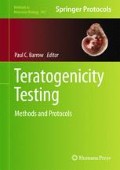Abstract
The rat is the rodent species of choice for the regulatory safety testing of xenobiotics, such as medicinal products, food additives, and other chemicals. Many decades of experience and extensive data have accumulated for both general and developmental toxicology investigations in this species. The high fertility and large litter size of the rat are advantages for teratogenicity testing. The study designs are well defined in the regulatory guidelines and are relatively standardized between testing laboratories across the world. Teratology studies address maternal- and embryo-toxicity following exposure during the period of organogenesis. This chapter describes the design and conduct of a teratology study in the rat in compliance with the regulatory guidelines. The procedures for the handling and housing of the pregnant animals, the caesarean examinations and the sampling of fetuses for morphological examinations are described. The utility and design of preliminary studies and the inclusion of satellite animals in the main study for toxicokinetic sampling are discussed.
Access this chapter
Tax calculation will be finalised at checkout
Purchases are for personal use only
References
ICH (2005) Harmonised Tripartite Guideline S5(R2). Detection of toxicity to reproduction for medicinal products & toxicity to male fertility
OECD (2001) Guideline for the testing of chemicals 414. Prenatal Developmental Toxicity Study
FDA (2000) Toxicological principles for the safety of food ingredients IV.C.9.b. Guidelines for Developmental Toxicity Studies (Redbook 2000)
EPA (1998) Health Effects Test Guidelines OPPTS 870.3700. Prenatal Developmental Toxicity Study
ICH (2009) Harmonised Tripartite Guideline M3(R2). Guidance on nonclinical safety studies for the conduct of human clinical trials and marketing authorization for pharmaceuticals
EU (2010) Directive 2010/63/EU of the European Parliament and of the Council of 22 September 2010 on the protection of animals used for scientific purposes
Tyl RW, Marr MC (1997) In: Hoo RD (ed) Handbook of developmental toxicology, 2nd edn. CRC, Boca Raton, pp 186–192
Barrow P (2000) Reproductive and developmental toxicology safety studies. In: Krinke G (ed) The laboratory rat. Academic, London, pp 199–225
US National Research Council (2011). Guide for the care and use of laboratory animals. 8th edn. http://oacu.od.nih.gov/regs/guide/guide.pdf. Accessed 14 Feb 2012
Decree n° 2001-464 regarding the experiments with laboratory animals described in the Journal Officiel de la République Française on 29 May 2001
Decree n° 2001-486 relating to the protection of animals used in scientific experiments described in the Journal Officiel de la République Française on 6 June 2001
European Parliament (2010). Directive 2010/63/EU of the European Parliament and of the Council of 22 September 2010 on the protection of animals used for scientific purposes
Dainty TC et al (2012) Dried blood spot bioanalysis: an evaluation of techniques and opportunities for reduction and refinement in mouse and juvenile rat toxicokinetic studies. Int J Toxicol 31(1):4–13. doi:10.1177/1091581811429493
Jonsson O et al (2011) Capillary Microsampling (CMS). Collection and analysis of small exact volumes of liquid blood or plasma samples. http://www.diahome.org/productfiles/25852/jonsson%20astrazeneca%20capillary%20microsampling%201compatibility%20mode.pdf. Accessed 11 Feb 2012
Salewski E (1964) Faerbermethode zum Makroskopischen Nachweis von Implantations Stellen am Uterus der Ratte. Naunyn-Schmeidebergs Arch Pharmakol Exp Pathol 247:367
Makris SL, Solomon HM et al (2009) Terminology of developmental abnormalities in common laboratory mammals (version 2). Birth Def Res B Dev Reprod Toxicol 86:227–327
Paumgartten F et al (2009) Harmonization of terminology in developmental toxicology: the quest for a more precise description and a harmonized classification of fetal observations. Reprod Toxicol 27(1):8–13
Barrow PC (2009) Reproductive toxicity testing for pharmaceuticals under ICH. Reprod Toxicol 28:172–179
Author information
Authors and Affiliations
Corresponding author
Editor information
Editors and Affiliations
Rights and permissions
Copyright information
© 2013 Springer Science+Business Media, LLC
About this protocol
Cite this protocol
Leroy, M., Allais, L. (2013). Teratology Studies in the Rat. In: Barrow, P. (eds) Teratogenicity Testing. Methods in Molecular Biology, vol 947. Humana Press, Totowa, NJ. https://doi.org/10.1007/978-1-62703-131-8_9
Download citation
DOI: https://doi.org/10.1007/978-1-62703-131-8_9
Published:
Publisher Name: Humana Press, Totowa, NJ
Print ISBN: 978-1-62703-130-1
Online ISBN: 978-1-62703-131-8
eBook Packages: Springer Protocols

